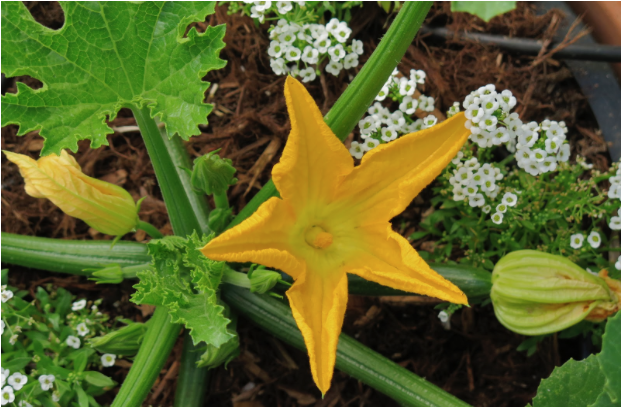Container Gardening: Growing Edibles in Containers

Interest in container gardening just keeps on, well... growing! Every year, new plant varieties are being bred specifically for small spaces. Vegetables and fruits are joining herbs and flowers on decks, patios, and balconies, allowing more of us to grow at least some of our own food. Though it is easy to get a container garden going, we’d like to share a few design, planting and irrigation tips with you.,
Containers
Your choices will be based on your budget, taste, amount of space, plant selection, and weight limitations. Lettuces are shallow growers, but tomatoes and peppers like to root deeply. When working on balconies or roofs, weight is an important factor. Ceramic or wooden containers filled with moist soil can get very heavy, so lighter plastic pots or grow bags and lighter soil mixes may be necessary. Nurseries or garden centers should have plenty of container options. The pots must have drainage holes.
Potting Soil
Regular garden soil is not well suited to container gardening. Choosing potting mixes with organic materials and coco fiber added will be helpful for moisture retention in full sun exposures. Compost, fertilizer, and mulch are just as important to container-grown edibles as they are to their counterparts in the ground. More so, really. Watering slowly and at low volume with drip irrigation helps avoid soil compaction in the pots.
Varieties
‘Little Gem’ and ‘Tom Thumb’ lettuces have been favorites for a while, but growers are constantly introducing new vegetable varieties that can succeed in cramped quarters. ‘Tumbling Tom’ tomato can grow in a hanging basket. ‘Patio Star’ zucchini and ‘Sugar Pot’ watermelon have a fraction of the spread of standard types, while still producing impressively. Ask your local nursery about good container varieties or buy seeds online.
Design
The classic design method for ornamentals in containers is “Thriller, filler, and spiller”. Thriller is the attention-getter, filler takes up the spaces, spiller gets planted on the edges so it can dangle over the sides. Edibles can be set up the same way. ‘Pesto Perpetuo’ (thriller) is a variegated basil that looks like an ornamental but is perfectly edible and does not flower. It grows 2’-3’ high. ‘Bambino’ is a compact marigold (filler) that grows about 8” tall. ‘Tumbling Tom’ tomato works as the spiller on the edge. Solo plants and dynamic duos are also good. Plants in the mint family will take over in a grouping and need their own space. Potatoes are best left as solo performers, too.
Irrigation
Watering container gardens is easier than ever, with drip irrigation systems and programmable timers. Drip Depot has a variety of container garden irrigation kits available, that will water from 10 to 120 containers. Kits are a great place to start. If a kit comes close but not close enough to meet your exact needs, you can use the ‘Build Your Own’ feature that allows you to easily customize it. All of our kits are designed to connect to a standard hose faucet. Adding a programmable timer gives you plenty of flexibility, and assures a regular watering routine, which translates into healthier and happier plants. You can also go on vacation with the secure feeling that your garden will be watered while you’re gone.
Fertilizing
When planting, start by filling the container about halfway with soil, and then spread a light layer of dry fertilizer according to package directions. Add more potting soil and another light fertilizer layer at around the one-quarter mark. During the season, some aged compost can be scratched into the surface of the soil periodically. Beyond that, incorporating a fertilizing system such as the EZ Flo hose end system is a great way to add a water soluble fertilizer that will help your edibles in pots achieve optimal health and performance.
Enjoy your container gardening adventure, and feel free to share photos of your projects on our Facebook page.